11 TOP SIGHTS IN CASTELFRANCO VENETO: THE ITALIAN RENAISSANCE MASTER GIORGIONE'S BIRTHPLACE
Painter Giorgione's town
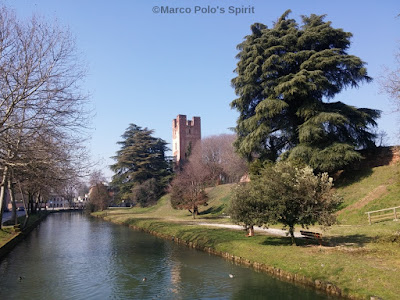 |
| Castelfranco Veneto is an unmissable Italian destination |
It is set in the low-land between the towns of Treviso, Venice, Padua and Vicenza, all within easy reach from Castelfranco Veneto (roughly 35 kilometres).
I have come here for the weekend several times because it's the hometown of one of the most mysterious Italian Renaissance painters, Giorgione (actually his real names was Giorgio Barbarelli da Castelfranco).
He left to the city two of his most stunning art works on display in the Duomo and in his house (now a museum). For an art lover like me, his appeal is difficult to resist!
We don't know much about his life and death, except that he died very young, at 30. However, before dying he made it in time to teach another Italian giant master, Titian, and meet the genius Leonardo da Vinci!
Recently I went to Castelfranco Veneto to visit the beautiful exhibition "Giorgione's plots and wefts" hosted in Giorgione's museum. The exhibition showcased not only his paintings, but also the fabrics and clothes used in his historical period
He seems to guide me to his town again and again! Given that he was interested in magic, I am starting to think that he has cast a spell on me...
 |
| Back side of Castelfranco walled town @Alessandro Vecchi |
Why visiting Castelfranco Veneto?
 |
| Castelfranco Veneto's towers @Alessandro Vecchi |
Any idea where Proseccoland is located? Read my blog post about the beautiful Proseccoland here to discover more.
In Castelfranco Veneto it is relaxing to stroll around, especially in spring and in autumn, because the town has amazing lawns surrounding its Medieval walls, and the region is dotted with breathtaking Venetian villas.
In Castelfranco Veneto there are still frescoed-facades on the many historic buildings, right in the heart of town and on Piazza Giorgione.
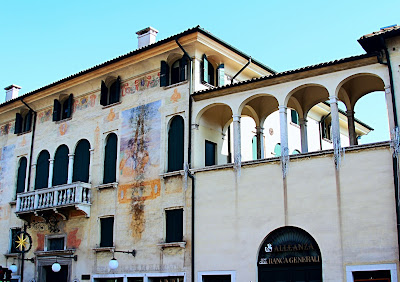 |
| Castelfranco Veneto hides wonderful painted facades and corners |
In Castelfranco Veneto music and arts have always played a critical role: in town there is a unique XVIII theatre, and one of the main music colleges in the region!
In Castelfranco Veneto you can "eat flowers"! Well, you can eat the local "radicchio variegato di Castelfranco", which is a special type of chicory. It is beautifully shaped like a white rose with red dots. Ask for the radicchio ice cream in the best local gelaterie in the summer!
In Castelfranco Veneto there is a good number of tourists all year round; however, it is a liveable town where you will never queue up and you will have extraordinary art masterpieces all by yourself!
From its unmistakable towers to the quaint walk around the castle walls, here are the top 11 things to see in Castelfranco Veneto.
 |
| Enjoy small bridges, wildlife and a relaxing atmosphere |
Stroll around the Medieval castle walls and moat
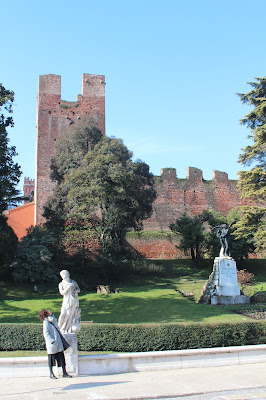 |
| Wander around the Medieval castle to explore Castelfranco Veneto |
The 12th-century moated castle is the highlight of Castelfranco Veneto. Why would a town otherwise be called "Castel-franco"?
In Italian the town name means "free castle" because in Middle Ages the people who lived in the castle had to defend it from their enemies! In return, they had to pay no taxes (it was a duty free port for its citizens!). I bet Harry Potter would be happy to live here too.
In Italian the town name means "free castle" because in Middle Ages the people who lived in the castle had to defend it from their enemies! In return, they had to pay no taxes (it was a duty free port for its citizens!). I bet Harry Potter would be happy to live here too.
Actually, you can see the 17-metre high walls, the 6 towers and the moat. The walk around Castelfranco castle is along a well-kept path, crossed by small bridges over the moat.
You don't have Tibetan bridges or adventurous ziplines to challenge you; however, children will be thrilled because the castle area is a good observation spot for wildlife, such as squirrels, swams, and ducks.
You don't have Tibetan bridges or adventurous ziplines to challenge you; however, children will be thrilled because the castle area is a good observation spot for wildlife, such as squirrels, swams, and ducks.
Tip: if you come here at the beginning of September, the gardens around the moat and the walls of Castelfranco Veneto will offer you something similar to Palio di Siena.
The "Palio d'amore" (the Love Palio) is a weekend-long medieval historical reenactment with falconry, handmade traders and flag wavers.
Take in the views of Castelfranco Veneto surrounding countryside from the tower top
 |
| A sight of Torre Civica |
If you feel like climbing three floors up a narrow spiral staircase on foot (no lift available), the "Forward Tower" (Torre Davanti or Torre Civica) is the best place.
This tower was built to protect Castelfranco Veneto from Padua and Vicenza's expansionist goals. After 800 years its slender shape is still there, and it has become the town's landmark with its 43-metre height.
From the top you can take impressive snaps of the countryside, and some well-informed locals told me that you can even spot Venice on a clear day.
Not sure about spotting Venice (when I was there was a slight haze!); however, when you climb down the tower, stop on the first floor. Through a glass trapdoor you will peep to the passers-by walking past the tower main gate. From that door the Medieval castellans used to pour boiling tar over the enemies!
Torre Civica opening days/hours:
Saturday: 11-13 15-19
Sunday: 10-13 15-19
Admission ticket prices
Full price 3,00 euros
Reduced price 1,5 euros
Spot a lion in the city's safari
Lion sightings are not a common thing around here, but -believe it or not- in Castelfranco you can expect to see a lion!Just walk under the Forward Tower and stand on the outer side of it: there you can see Saint Mark's winged lion roaring since 1339 when the Venetian Doge had it placed here after the Republic of Venice conquered Castelfranco.
However, apart from the lion's proud behaviour, you don't need to fear anything: he is holding an open Bible which was a symbol of peace for Venice.
Explore Giorgione's mysterious home frieze
 |
| Giorgione's house next to the Duomo |
Since its refurbishment in 2009 and once the home of one of the most significant painters of the Italian Renaissance, Museo Casa Giorgione is now home to a permanent exhibition, including Giorgione's mysterious frescoed frieze.
If you can't decide between Astronomy and Astrology, Mathematics and fortune-telling, then Giorgione's wall frieze in the museum is something you need to see.
Before painting this masterpiece in 1502-3, Giorgione was influenced by the Castelfranco-based Neapolitan mathematician-doctor-astrologist, Giovan Battista Abioso, who had predicted the end of the world in 1496 connected to a moon eclipse. The bad omen would have brought upheavels and misfortunes!
 |
| The mysterious frescoed frieze by Giorgione |
This is why the uncanny fresco is said to be full of allegories and occult symbols. Have fun spotting old instruments, sandglasses, calipers and figure out their uses!
There are more treats in store for you because the Museum offers special exhibitions regularly.
Museo Casa di Giorgione opening days/hours:
Tuesday to Thursday: 10-17
Friday to Sunday: 10-18
Closed on Easter Sunday and Monday; Christmas and 1st January
Admission ticket prices
Full price: 5 euros
Reduced price: 3 euros
Family: 10 euros
For more info about the museum, click here.
 |
| Details of Giorgione's frieze |
Museo Casa di Giorgione opening days/hours:
Tuesday to Thursday: 10-17
Friday to Sunday: 10-18
Closed on Easter Sunday and Monday; Christmas and 1st January
Admission ticket prices
Full price: 5 euros
Reduced price: 3 euros
Family: 10 euros
For more info about the museum, click here.
Share the emotions of a heartbroken father and Madonna in the Duomo
 |
| Giorgione's Madonna in the Duomo |
What gets your attention when you stand in front of Giorgione's masterpiece are the awesome colours: the Madonna's blood-red gown and the velvet backdrop, as well as the different green shades of her top, the landscape and the embroidered mat on her throne.
The other striking thing is that the Madonna is sitting on a throne, not in a church as you might expect her to be, but in an open-air landscape, as if she was one thing with all the nature around her.
Despite the bright colours, everything is emotional in the painting: the Madonna's and Child's eyes stare sadly to the ground. In fact, if you do the same, on the chapel floor you see the white tomb of a knight, Matteo Costanzo.
Matteo was 23 when he died in a battle in 1503: he was fighting in a war campaign for Venice during the Crusades. He came from the Costanzo noble family from Messina (southern Italy) and his father, Tuzio, was a famous military leader who had worked for the Republic of Venice.
When you stand there you can feel Tuzio's grief for his son's death: he was overwhelmed and wanted to celebrate in the painting Matteo's courage and deeds.
Before going, if you wonder how Matteo looked like, look at the handsome armoured knight to the left of the Madonna. His face is Matteo's!
 |
| Matteo Costanzo's tomb is below Giorgione's Madonna |
Haven't I seen the Castelfranco Duomo somewhere else?
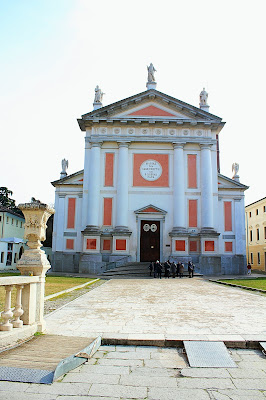 |
| The Duomo in Castelfranco Veneto by Francesco Preti |
 |
| The Church of Redentore in Venice on the Giudecca island |
Francesco Maria Preti is the architect who designed the Duomo in Castelfranco based upon Palladio's Redentore church. What Preti borrowed in 1723 from Palladio (who had died 100 years earlier) was a brillinat idea: the enlighted idea of applying the rules of harmony that we hear in music to architecture!
Francesco is still in the church safeguarding its secret: his tomb is on the nave floor.
Duomo opening days/hours
Every day: 9-12 15-18
No tours during masses
Free of charge
Tip: Don't miss the church vestry (generally locked but accessible to the public) showcasing amazing paintings by painter Paolo Veronese saved from the knocked-down Soranzo Villa and Emmaus Supper by the painter Paolo Piazza.
The latter depicts fashionable clothes and laces in the XVII century! Contact the church attendant to visit the vestry masterpieces.
 |
| Hidden church vestry cocoons Paolo Veronese's art works |
Spy on the nobles' secret gatherings in the Studiolo
Not far from the church there is a tiny room beautifully frescoed in red in 1400. It seems that the decorations and coat of arms of many local noble families depicted refer to secret meetings which were held in here.
Above the chimney you can spot a painted woman who is keeping her eyes, and mouth closed and shows her ears in her hands, as if she was telling is: I see no evil, hear no evil and speak no evil. Therefore, it is thought that this room was used for secret gatherings of the aristocracy from the place...
It is a pity that the woman cannot enjoy and feel the softness of the textiles on display in her room: they come from the local woolen company, Lanificio Bottoli, producing fine Italian wools since 1861.
The master weavers from Bottoli -which today uses organic cloth dye- got their inspiration for colours and designs to make original fabric in natural fibres from the coat of arms on display in the room!
 |
| The woman on the chimney and the painted decorations |
Visit a unique theatre that was a meeting room once
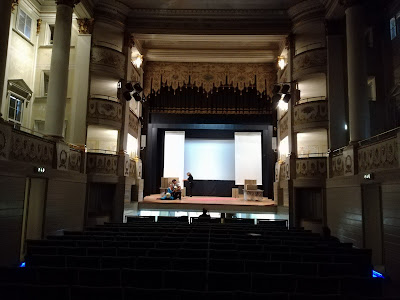 |
| Cute little gem Teatro Accademico |
 |
| Unique feature: Castelfranco theatre has windows! |
Later the conference room turned into a theatre which today has become the Teatro Accademico. Given that the place was a meeting room in origin, it was built so that the audience and not the stage was central!
The other key feature is that the room was used during the day and at night, that is why there were both windows and torches.
The final awesome feature is that the theatre has an amazing acoustics because Giovanni Rizzetti, a mathematician who was member of the Riccati's club, studied a special acoustics just for the place.
All you have to do is come and test the acoustics for yourself by attending one of the many theatre performances all year round.
Enter an old 15th century Venetian Palace through ...the chimney
 |
| Getting into Casa Costanzo from the chimney |
Tuzio Costanzo, Giorgione's customer who commissioned the Madonna of Castelfranco, lived in the old Venetian Palace called precisely Casa Costanzo, not far from the town church. If you visit it you will come in through a door where there was the old fireplace in origin.
The house was build for Matteo Costanzo who died in 1498 and who never lived here: his frescoed coat of arms and the decorated red ornaments stand out on the walls.
What captured my attention were the amazing textiles such as handmade velvets and damasks on display in the room wardrobe. They belong to Tessitura Bevilacqua based in Venice which is the oldest weaving factory still active in Europe (first mentioned in a 1498 document!).
The company is so famous that they sell their valuable textiles to decorate the Oval Room or the Kremlin!
Another local textile company fabrics on display in Casa Costanzo were the stunning silk clothes and production from Azienda Serica 1870.
Their silk is very light, and has special colour features: so special are theythat they manage to sell silk in China too!
Before leaving the house cast a glimpse to the beautiful Venetian three mullioned window that is still there since 17th century!
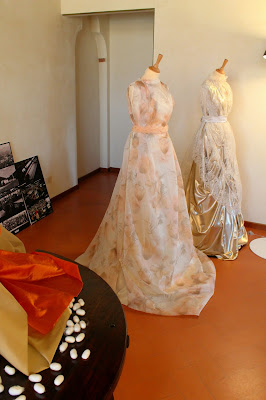 |
| The wonderful silk gowns from Serica 1870 |
Marvel at fine hand-woven tapestries and high fashion chair seating covers at Casa Barbarella
 |
| The Barbarella House's huge front steps leading up |
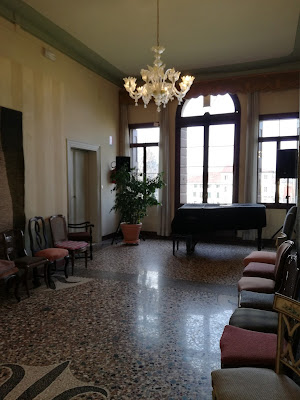 |
| The main hall |
As a matter of fact, the villa is built on an high-up embankment: from the main villa hall you can look onto Piazza Giorgione, the main town square!
 |
| Villa Barbarella hall looks onto the main Piazza Giorgione |
Giorgione himself came from the Barbarella family, his father being a notary public. His family built this stunning villa covered with marble grit floors called "Venetian floors" as you often see them in Venice Gran Canal Palaces.
When I visited the villa hall, its walls showcased current textile productions from the area around Castelfranco which has a long tradition in this sector, i.e. valuable woolen tapestries and fashionable seating covers.
Renata Bonfanti tapestry company and Lanificio Paoletti are both an excellent example of local excellence, and are fashion research centres which pair a long standing weaving tradition with top innovation.
 |
| Wonderful top-market craftsman's works on display in the villa hall |
For once enjoy getting lost in a park: have fun at Revedin-Bolasco Park
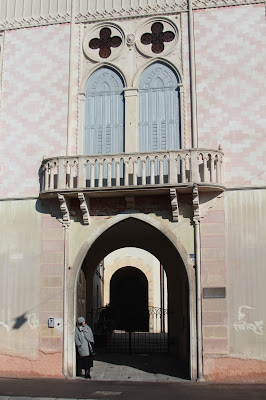 |
| The Venetian windows on the Revedin-Bolasco Villa front facade |
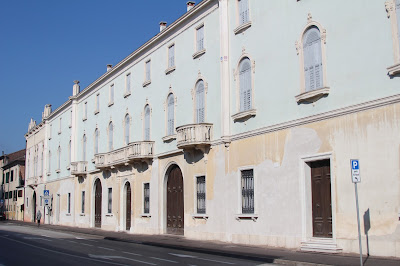 |
| Behind the Villa Revedin Bolasco facade there is a magnificent park |
The original villa is dating back to XVI century when the aristocracy from Venice used to come here on holiday. However, in 1700 the villa was rebuilt completely, together with its astonishing 7-hectare English garden.
Walk around the 2-hectare lake which was designed by the architect Antonio Caregaro Negrin from Vicenza, who had predicted that you would enjoy the park more with a lake!
The park is full of gigantic and exotic plants: you can learn more about them if you take the weekend guided tours by students from the Padua University, the current owner of the place (book in advance here).
If you feel unders scrutiny, you might be right: 48 marble statues placed in a circle cast their glances in all directions: this was the spot where Count Revedin, one of the last owners, used to ride his horses.
 |
| Villa Revedin Bolasco hides a park full of rare plants and peaceful views |
In brief
Getting there
Castelfranco is conveniently located, so it is easy to reach by train, bus or drive.By train: it is very easy to jump on the train and get off in Castelfranco train station. Venice Santa Lucia to Castelfranco Veneto is about 1 hour on a slow regional train. Click here to check out the train timetable.
By bus: you can reach Castelfranco from Treviso. The bus company is called La Marca. Timetable changes according to the season (from middle September till June you have the winter timetable). Click here to check the bus timetable.
By car: it is the easiest option. From Venice it takes about 1 hour and a half (roughly 65 km). Take the A4 motorway, exit Padova est. Click here to check out the car itinerary. You can rent a car here.
By air: Castelfranco is close to Treviso airport (22 km). Click here for more airport info. Venice airport is 45 km away (roughly 1 hour and a half). Click here for Marco Polo Venice airport info.
More information
For the tourist information office in Castelfranco Veneto, click here.
For tourist information about the area around Treviso, click here and here.
To learn more about the Palio held in September, click here.
To learn more about the famous local chicory "radicchio variegato di Castelfranco", the events and the recipes, click here.
For accomodations in Castelfranco Veneto, click here or here.
To read more about Giorgione, click here or here.


